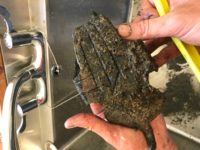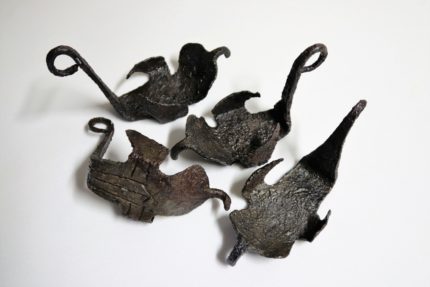A set of four iron hipposandals has been unearthed in the archaeological motherlode that is Vindolanda, the Roman fort and settlement just south of Hadrian’s Wall in Northumberland. The set was discovered by a volunteer in a system of ditches adjacent to a late Antonine stone wall (180-200 A.D.). There were three main phases of construction in the Antonine era with new ditches dug for each which narrows down the date of the hipposandals to between 140 and 180 A.D.
 These iron hoof coverings were used to protect the feet of military and pack animals, horses, perhaps even oxen. They were clunky and would have hindered movement, but they would have helped the animals keep their footing in mucky, wet, slick and snowy conditions. It’s possible the hindrance of movement was a feature rather than a bug; an animal at pasture wearing these clodhoppers would be effectively hobbled and incapable of wandering off. They also served as a barrier against injuries accidental and deliberate, as from caltrops.
These iron hoof coverings were used to protect the feet of military and pack animals, horses, perhaps even oxen. They were clunky and would have hindered movement, but they would have helped the animals keep their footing in mucky, wet, slick and snowy conditions. It’s possible the hindrance of movement was a feature rather than a bug; an animal at pasture wearing these clodhoppers would be effectively hobbled and incapable of wandering off. They also served as a barrier against injuries accidental and deliberate, as from caltrops.
Hipposandals have been found before, particularly on battlefields where they were shed by cavalry mounts, but a complete matched set of four is an extremely rare discovery. The hoof protectors are in excellent condition, showing so little wear and tear that the treads on the underside are still clearly visible.
More than 7,000 volunteers have played an essential role in the excavation of Vindolanda since the program began in 1970. Volunteers have helped unearth everything from the thousands of leather shoes and writing tablets the site is best known for, to the bronze hand from the shrine of Jupiter found a few months ago.
Because the Romans were in Britain for between 400 and 500 years, Ms Birley said, teams could dig at the site for the next 150 years and still unearth Roman treasures.
“Basically, over the years, nine forts have been built on this site – every time new Roman arrivals came, they covered over the remains from the last fort with clay and turf to make solid foundations for their fort,” Ms Birley explained.
“This means things were well preserved. One of the hipposandals has a hairline fracture so the set may have been thrown in the ditch because one was damaged.”
The hoofwear has been conserved and will go on display at the Roman Army Museum in February of next year.

I wonder if these had any protective use in certain battle situations. It seems unlikely but might these sandals help protect a horses hooves when the opposing forces lay down a number of caltrops?
Thanks largely to this blog, we recently visited Vindolanda as part of our UK vacation. It was every bit as amazing as you make it sound here. Can’t wait to be retired and volunteer.
Does anyone know how these were actually attached to the hoof? I did a google and couldn’t find anything that explained it
Dear Cheryl,
Hipposandles (“hippo”=horse in Latin) were the forerunner of horseshoes. They were plates attached to the bottom of the horse’s hooves by tying them around the horse’s lower legs with straps or cords. I believe that the long loop was in the front and, as you can see in the photos, the bottom plate was bent around the sides of the hooves. Because they were not as tightly attached as horse shoes and were heavier they did not work as well and worked loose fairly easily.
I had not thought of the fact that hipposandles would armor a horse’s hoof against caltrops but it makes sense.
Correction. The long loop on a hippo sandal, according to the Wikipedia article, goes on the back of the hoof.
Take a modern “hoof boot”, think away the leather strips and inner and outer layers, and imagine the inner part made of a different material. According to the Roman politician Vespasian, however, (on which Sueton reported), the process was an arduous one:
——–
“On a journey, suspecting that his muleteer had got down to shoe the mules merely to make delay and give time for a man with a lawsuit to approach the emperor, he asked how much he was paid for shoeing the mules and insisted on a share of the money.”
“Mulionem in itinere quodam suspicatus ad calciandas mulas desiluisse, ut adeunti litigatori spatium moramque praeberet, interrogavit quanti calciasset, et pactus est lucri partem.”